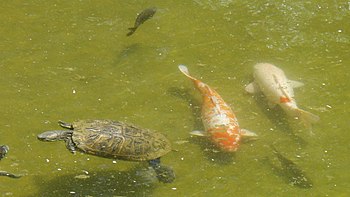 |
| Red-eared slider turtle and Koi fish (Photo credit: Wikipedia) |
Koi, like any other pet, will have medical issues throughout its life, especially since Koi have been knowing to have a lifespan of up to 30 years. You contact the vet because you Koi is showing signs of injury or illness, and unless you have a vet that does house calls, chances are the first thing they will say is “bring it in.”
Issues with your pond can arise, whether it is an emergency move because your pond is placed into harm's way by natural events or a planned move due to new construction. No amount of planning can ensure that you will not have to move your Koi for one reason or another.
With the problems that arose from recent events such a Hurricane Katrina and Hurricane Rita and everyday events such as common illnesses, it is imperative that you have a plan of action when it comes to your pride and joys. No matter if it is an emergency or not, knowing how to properly bag and transport your Koi could mean the difference between life and death.
Equipment Needed
First, it is always a good idea to have all the equipment needed to transport your Koi on hand. If you are having an emergency with your Koi, you may or may not have time to make a trip to your local pet store to gather what you need. The equipment needed to bag and transport Koi is small and easily stored when not in use.
Bags- You must have the proper bags on hand to transport Koi. Do not attempt to transport your Koi in the trash or regular plastic bags, as they are not designed for this, and may cause damage to your Koi. Unless you remembered to keep the bags you brought your koi home in originally, you will have to make a trip to your local pet store. Make sure to get bags sizable enough to hold your Koi.
Rubber Bands- You will need quite a few rubber bands for each bag you buy. Make sure that your rubber bands are good quality, as you do not want the pressure from the water to pop the rubber band in the middle of the transport.
Net- You will need to have a net sizeable enough to compete with your Koi. You will never need the net to pull the Koi out of the water with, but you will need it to lead and direct your Koi into the place you want them. Nets can potentially damage your Koi, especially as the larger they get.
Paint Bucket- A paint bucket is a better option for catching your Koi, as they cannot hurt your Koi like a net can. Make sure that your bucket is sizable enough to hold your Koi.
Bagging your Koi
The process of catching and bagging your Koi is actually pretty simple as long you have the proper equipment available. If your pond is large, you may want to consider enlisting the help of your friends when bagging your Koi.
Use the net to guide the Koi into the Paint Bucket. Once the Koi is in the paint bucket you can remove any excess water, and begin bagging the Koi.
Make sure that you check the bags for leaks. Once you are sure that the bag is secure, place the bag over the Koi from head to tail. Make sure there is enough water in the bag to completely cover the gills. Leave plenty of air room so that the bag is not too heavy to carry. Slip the rubber bands around the end of the bag and continue to double it until the bag is secure.
Place the bags horizontally in your transport container. Make sure that you do not bend the fish when lifting it. Secure the bag so that it will not move with bumps and turns, and cover the fish so that as little heat and sunlight can enter as possible.

No comments:
Post a Comment